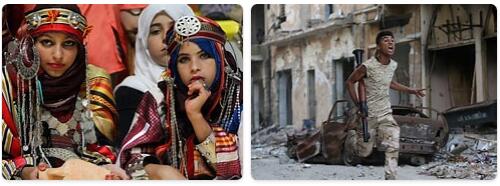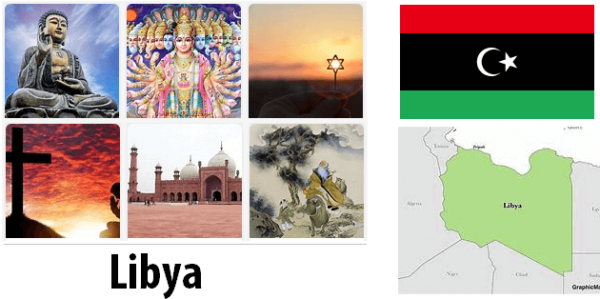Libya is Africa’s most developed country. UNDP’s 2009 HDI index placed Libya in first place in Africa.
The popular, Arab and socialist Yamahiriya – known as Libya – has historically occupied an intermediate position in the political-economic relations in North Africa. Its location on the Pharaohs of Egypt influenced its cultural development, but even though two Libyan dynasties ruled Egypt in it 10-8. century BCE a single state was never formed. The development of another political-economic pole at the country’s western border – Carthage and later the Romans – promoted this duality. After the Arabs conquered the area in the 7th century, the centers of power on one side of Tunisia and Morocco and on the other of Egypt.
The development of the trade at sea and the pirate business transformed Tripoli into one of the most important ports in the Mediterranean, and this was the background of the first European and then the invasion of the Turkish sultan. In 1551, Solomon incorporated the Radiant Territory into the Ottoman Empire. However, with the weakening of central power, the governors gained ever greater autonomy, which provided the basis for the development of independence projects. In the early 19th century, the pirate business was also a pretext for the United States’ first military intervention abroad. In 1804, the United States bombed Tripoli.
In 1837, Mohamed al-Sanusi formed a secret Muslim Brotherhood, known as Sanusiya. A Puritan religious movement that arose among the tribes and inhabitants of the eastern part of the country. Its purpose was to promote opposition to the Turkish government, and it also acted in Egypt. But the enemy would later become another. In light of the decline of the Ottoman Empire, Italy declaredin 1911 the empire war and occupied the Libyan coastline – the last possession of the Ottomans in North Africa. At the outbreak of World War I, the Italians reduced their presence to the ports of Tripoli and Homs (Al-Khums), while the rest of the area was in fact independent. When the world war was over, the Italian invasion forces were facing a fierce armed resistance led by Sidi Omar al-Mukhtar. It was only when he was captured and hanged in 1931 that the area came under control and was incorporated into the Italian kingdom.
The Sanusi movement was active in neighboring Egypt and cooperated with the Allies during World War II. The leader of the fraternity, Idris al-Sanusi, was recognized by the English as Emir of Cirenaica. When the world war was over, the area was divided into two zones. One – Tripoli and Cirenaica – was administered by the English, while the other – Fezzan – was administered by the French from Chad. In 1949, the United Nations decided to unite the two zones and the independent kingdom of Libya was formed with Idris al-Sanusi on the throne.

1949 Independence
The poor economic base of the new state and the king’s conservative and western-oriented rule tied the country closely to the interests of western imperialism. Up to the 1960s, the taxes of the North American and British military bases in the country accounted for half of Libya’s national income. In 1959, the oil company Esso found oil in the desert of Libya, and through the 1960s oil production expanded rapidly. North American companies accounted for 87% of production. The nation’s revenues from oil production accrued to a small dominion of leading families, local businessmen and the middlemen of imperialism.
At the same time, inflation and a lack of agricultural development led to a decline in rural employment, which triggered emigration to the cities and a slum life. The influence of the pan-Arabian currents in other Arab countries and from Nasser in neighboring Egypt played a major role in political awareness. Among the educated youth from the lower social strata, a strong dissatisfaction developed. Among other things. because their only options in society were a career in the military. This was the case, among other things. Muammar Gaddafi – born in 1942 as the son of a Bedouin family.
Criticism
Both during and after the war, critical questions have been raised about international handling in general and military intervention in particular – as well as how the warring parties behaved.
The political-legal basis for the intervention – that is, the responsibility to protect civilians (R2P), which was crucial both for UN resolution number 1973 and for Norwegian participation – has also been questioned. It was not clear that the regime intended to take military action other than against armed rebels, and when resolution number 1973 was passed, fewer civilians were killed in Benghazi than during the Cairo uprising at a similar time.
When Operation Odyssey Dawn was launched, there was a military advance from the regime against Benghazi, but no clear indications that it would be deployed against the civilian population. Questions have also been raised about the reality of the regime’s alleged use of mercenaries, which is expressed in UN Resolution 1970. It was not established that the regime had such strengths when the intervention was implemented, and it has not been proven that it used mercenaries during the war.
As was the case with the US-led invasion of Iraq in 2003, questions were raised about the true intention behind NATO’s war in Libya, propelled by France and supported in particular by the United Kingdom and the United States. The great oil resources of the Arab states – and their radical national politics – are in both cases pointed to as the motive for the desired regime change.
The Arab Spring threatened stability not only in North Africa, but more importantly in the region in general and in the Gulf states, with Saudi Arabia in particular. As in Syria, several Gulf states later became involved in the Libya conflict, partly directly military, partly economic and political. As in Syria, support was also given to Islamists, although they were weaker in Libya.
The role of the United States, politically and militarily, has been questioned after years of policy for, and multiple attempts to remove, Muammar al-Gaddafi. Libya’s foreign policy was independent, anti-imperialist and anti-Western. One interpretation of the US role during the Libyan uprising, among other things, is that Gaddafi’s pan-African politics was a threat to the United States’ struggle for influence on the resource-rich continent, at a time when China had established a significant foothold there.
Over the years, there have been several attempts by Western countries to kill Gaddafi. Questions have been raised as to whether it was in line with the mandate that the NATO operation in 2011 attacked his living quarters in Tripoli. It was justified that the residence was also considered a military command center. There was surveillance from Operation Unified Protector that Gaddafi found outside Sirte in October 2011, and it was NATO aircraft that bombed the convoy he was in UN mandate.
According to thesciencetutor, France’s leadership role is also linked to a possible desire by French President Nicolas Sarkozy to remove Gaddafi to cover relations between the two, with alleged financial support for Sarkozy’s election campaign. He was arrested in 2018, suspected of this. Along with US Secretary of State Hillary Clinton, Sarkozy called for Muammar Gaddafi to be removed.
